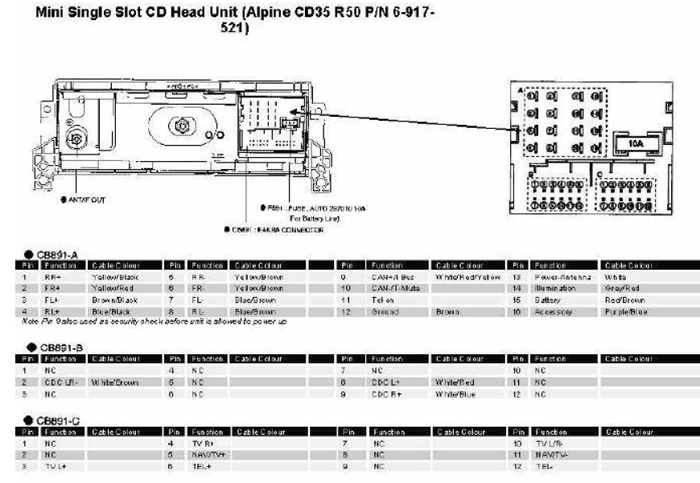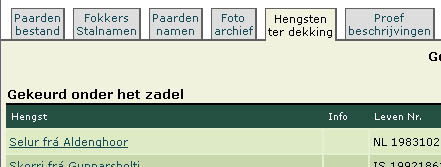
But even nowadays, a simple aux-input on the radio is not a standard option. And who listens to music without an mp3 player/ipod?
I have bought an Archos mp3 player with 20Gb disk a couple of years ago, and although it's large and old, and it has a slow USB 1.0 port, it still functions as my music take-away. But without an input on the car radio, it's useless.
But no worries, a bit of googling suggested a solution.
unfortunately, this did not work for me, as other people in the article suggest, it works only for *some* radio models.
So I started some experiments. First, get the radio out. The plastic cover under the steering wheel is locked by some "clicking" pins, so a hard pull will tear it down. This makes room to unscrew both torx screws on the left and right side of the radio compartment.
My radio turns out to be BMW radio, probably from Alpine.
The back reveals a few connectors:

The pin layout is described in this picture, that can be googled for:

So connecting the audio output to pin 3,4 and pin 10 was the first tryout. Cutting an old PC-USB port connecter in pieces was sufficient to get everything connected: (green=pin3 pink=pin4 white=pin10)
But no success. The problem is that the radio does not "recognise" the aux input, and the MODE key doesn't include AUX in its options. So what is the trick?
I noticed that turning the volume up and clicking on the mode key very rapidly sometimes DID give the AUX menu for a second or so. So I guessed it should be some kind of impedance/resistor pull up or pull down. So after some experiments I came up with this little thingy:
Basically, it connects the left and right channel with a resistor. To uncouple the audio lines, a small capacitor is used (220n). This seemed to work at first, but some music passages made the AUX menu go away. So I made the resistor smaller and smaller. I also tried to connect it to pin 9 and/or pin 10 as well:
Finally, the best solution for me was this schematic:
C1:220nF
Left audio --------||--+---------+----- pin 3
| |
+-+ | +-------+
| | +-| 10k |---+
| | R1:1k2 +-------+ |
| | +-------+ +--car ground
+-+ +-| 10k |---+
| | +-------+
Right audio -------||--+---------+-------- pin 4
C2:220nF
Audio Ground -----------||-------------------- pin 10
C3:2uF
Note: Because the output impedance of the MP3 player is low (speaker output, typically 1-50 ohms) the 1k2 resistor does not have a large impact on stereo separaion.
[ 1 comment ] ( 41 views ) | permalink | related link |




 ( 3 / 1082 )
( 3 / 1082 )The normal case: been busy for my latest project, and after a few days of sweat to produce the finest .exe, I dont care about installation and give the exe to everybody "to try it out". But nowadays, that's hardly acceptable: nobody expect an application to be "just an exe" that you need to put in a /program files directory yourself. So what's availbale?
I've been using InnoSetup. From a very simple version that I've got a few years ago it has grown to a full blown installation program. It support scripting, is multilangual, and there are aven a lot of design tools especially created for InnoSetup. So it is the obvious choice for me. But maybe there are alternatives.
There is microsoft, with their msi "technology" which is -as usual- very complex wihout much more features. I hate steep learning curves, so after a few tries, I decided not to use it. The concept is good: instead of writing procedural code, you just define what you need installed where, and it does the job for you. But getting rid of a procedural language should make the job EASIER, not HARDER. And there are no real benefits. So goodbye msi.
Then I investigated the "usual suspects": Wise and Installshield, the 2 top commecial installers available. Everybody with experience with both told me to skip installshield and go straigt for wise, because it was superiour. Because I had a legal version of wise 9, I tried it. But even this newest version has a windows 3.1 feeling, that you might get rid of with all kinds of patches and images, but in the end you are still stuck without normal Windows XP controls (like the green progressbar) And the wise "language" made me sick. If this is the commercial state of the art, then forget it and go straight to open source, because innosetup is way way superior over wise.
After this experience, I forgot about installshield. If this is not better than wise, it is not worth to investigate further.
And then there is NSIS. This is also open source, and is derived from the winamp installer. It is a comic farting lama counterpart of inno. It looks reasonalby good, at least as good as the wise installer, but also here you get a windows 3.1 feeling which goes away after a lot of "cosmetic" stuff.
Conclusion: Innosetup lives up to its expectations and is still my number one choice.
[ 1 comment ] ( 1392 views ) | permalink | related link |




 ( 3 / 1173 )
( 3 / 1173 )I've just finished a new version of the icelandic-horses website. Because it's a fairly large site, I decided to use tabs on top of the page, to make navigation simple and intuitive.
Just looking for what is available on the net, i found lots an lots of nice implementations, however, they all were very complex, used a lot of javascript or everything was done with images/tables. I wanted a PHP/CSS solution without images, and in fact, it turned out very simple, and looks like this:

(no javascript and only 1 image used: a transparant dot (a gif file of 1x1 pixel, transparant)
Here is the class code:
class txtwebmenu {
var $objs; // all assigned objects
var $atxt = array();
var $aurl =array();
var $aopt =array();
var $nrobjs=0;
var $cursel="";
// additem - add a menu item,
// $item = the item ID
// $txt = default/normal image
// $url = jump-to url on select
function additem($item,$txt,$url="",$opt="") {
$this->atxt[$item] = $txt;
$this->aurl[$item] = $url;
$this->aopt[$item] = $opt; // options
}
// genmenu - the payoff: generate the whole thing
// $sel = item id of current selected item
function genmenu($sel="",$msize=2) {
if (strlen($sel)>0)
$this->cursel=$sel;
echo "<table border=0 cellpadding=0 cellspacing=0 width=100% bgcolor=white>";
echo "<tr><td height=3><img src='/ijs/gifs/transdot.gif' border=0></td></tr>";
echo "<tr><td>";
echo "<table border=0 cellpadding=$msize cellspacing=0>";
$ffirst=true;
reset($this->atxt);
while (list ($item, $txt) = each ($this->atxt)) {
echo ($ffirst) ? "<tr height=14><td class=twbspc><img src='/ijs/gifs/transdot.gif' border=0 width=6></td>" : "";
$target= (strchr($this->aopt[$item],"T") ? "target='_blank'" : "");
if ($this->cursel==$item) {
printf("<td class=twbmnuS align=center nowrap >");
echo "<a class='twbmnuS' href='".$this->aurl[$item]."' $target >$txt</a>";
}
else {
printf("<td class=twbmnu align=center nowrap>");
echo "<a class='twbmnu' href='".$this->aurl[$item]."' $target >$txt</a>";
}
echo "</td>";
echo "<td class=twbspc><img src='/ijs/gifs/transdot.gif' border=0 width=".($msize>1?"4":"2")."></td>";
$ffirst=false;
}
echo "<td class=twbspc width=100%><img src='/ijs/gifs/transdot.gif' border=0 width=1></td>";
echo "</tr>";
echo "</table>";
echo "</td></tr>";
echo "<tr><td bgcolor=#F2F1DD height=3><img src='/ijs/gifs/transdot.gif' border=0></td></tr>";
echo "</table>";
}
}
And here is the CSS. Acutally the whole "tab" look is done with borders in CSS:
TD.twbmnuS {font-family: verdana,arial,helvetica,sans-serif; font-size: 11px; font-weight: normal;
border-style:solid; border-color: #606060; background-color:#F2F1DD;
border-top-width: 1px;
border-left-width: 1px;
border-right-width: 2px;
border-bottom-width: 0px;
padding-left: 2px; padding-right:2px;}
TD.twbmnu {font-family: verdana,arial,helvetica,sans-serif; font-size: 11px; font-weight: normal;
border-style:solid; border-color: #606060; background-color:#DDDDDD;
border-top-width: 1px;
border-left-width: 1px;
border-right-width: 2px;
border-bottom-width: 2px;
padding-left: 2px; padding-right:2px; }
TD.twbspc {border-style:solid; border-color: #606060;
border-top-width: 0px; border-left-width: 0px; border-right-width: 0px; border-bottom-width: 2px; }
A.twbmnu:link {text-decoration: none; color: #164B56; xx: #567181;}
A.twbmnu:visited {text-decoration: none; color: #164B56; xx: #567181;}
A.twbmnu:Hover {text-decoration: underline; color: #000000; }
A.twbmnuS:link {text-decoration: none; color: #000000; }
A.twbmnuS:visited {text-decoration: none; color: #000000; }
A.twbmnuS:Hover {text-decoration: underline; color: #000000; }
And here is a sample how to use this class:
<?
$mo = new txtwebmenu; // a new tabmenu
$mo->additem('nr1','Item1',"item1.php?curmenu=nr1");
$mo->additem('nr2',"Item2","item2.php?curmenu=nr2");
?>
..html..
<? $mo->genmenu($curmenu); ?>
...html..
You could use separate php files for each tab-page, or use one "big" php file with all pages. With additem, you just supply the url of the page itself.
If you use separate php files, be sure to include the code above in every file (with an include)
The $curmenu var indicates which tab to highlight. Be sure to set it right, otherwise all tabls are grey
[ 25 comments ] ( 807 views ) | permalink | related link |




 ( 3 / 1054 )
( 3 / 1054 )Changing from one editor to another... wow! An editor is a tool that i'm using so much, that changing from one to another feels like moving to another appartment.
On windows, I'm using homesite 3 for quite some years. Homesite 4 and 5 never attracted me: adding feature after feature to a product seldom makes it better. The new homesites were slower and less stable. So why change?
On unix, i'm using vi. But the reason for that is that its always available, and there are no alternatives, except for emacs, but that doesn't feel good. It has a steep learning curve, and i can't waste time learning an editor. On unix I stick with vi for a while.
But now, homesite 3 feels a bit outdated, and some issues are irritating.
So what are editor knock out criteria for me:
- stability. Losing a text file is not acceptable.
- lean and mean. Speed is essential
- correct tabs/indents. Most editors fail on this, create spaces instead of tabs etc.
- No silly mistakes with arrows and del keys. There are some simple rules that an editor needs to follow: backspace on the beginning of a line adds the line to the previous one, cursoring down may not change column position
- line numbers
- unlimited line length
- I like the homesite explorer-window on the left. It has become natural for me
- Multiple file editing, with one-click (tabbed) file changing
And a few nice to haves:
- ftp integration. Using an ftp-server as if you're working local (this is the reason I want to dismiss homesite3)
- overview/compression mode.
So I downloaded a few editors to see which one had it all. It turned out to be a dificult search:
Notepad++ - feel is good. However, no explorer toolwindow on the left.
Syn - No correct tab/indents. For the rest it seems ok
Jedit - ugly as hell (thanks to java), slow, no explorer window
MED - no correct tab/indents. Not lean and mean. Lot of useless stuff.
TexEdit - silly key mistakes. Does not feel natural. Bad indent/tab
Crimson - Feel is ok. No siilly mistakes. Tab/indent is a bit hidden, but the implementation is ok. It has a nice ftp feature, although not transparantly integrated it works ok. This is an editor that I will try for a while to see if it sticks.
[ add comment ] | permalink | related link |




 ( 3 / 923 )
( 3 / 923 )Oracle installations are always a pain, and on a non-supported distro like gentoo it will probably be much worse. Lets see what we get.
The oracle CD (9.2) contains a script called runInstaller.
* Create a user oracle and group oracle to run this script in.
* run runInstaller from the cd as user oracle
The default gentoo fstab for cdroms does not allow running scripts from cd.
You will get a bash: permission denied error, even if the file is x-r.
(Oracle uses a shebang to sh instead of bash (#!/bin/sh) in their script, so i was first on the wrong track checking the sh link (/bin/sh -> /bin/bash) but that was fine)
the reason is the gentoo folks advise you to put the 'user' option on the cdrom mounts. But this also implies 'noexec'.
You need to add 'exec' to the /etc/fstab cdrom mount line options:
/dev/cdroms/cdrom0 /mnt/cdrom auto noauto,user,exec 0 0
* You need to emerge lib-compat. If not emerged, you'll get an error because oracle can't find libstdc++-libc6.1.1.so.2
The next the error is:
Unable to load native library: /tmp/OraInstall2005-01-02_07-02-08PM/jre/lib/i386 /libjava.so: symbol __libc_wait, version GLIBC_2.0 not defined in file libc.so.6 with link time reference.
See if I can fix this one in the next post.
[ 1 comment ] ( 338 views ) | permalink | related link |




 ( 3 / 210 )
( 3 / 210 )Back Next

 Calendar
Calendar




